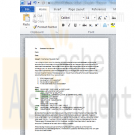Search results for 'university'
-

New Perspectives on HTML and XHTML Tutorial 3 Case Problem 3
$12.00New Perspectives on HTML and XHTML Tutorial 3 Case Problem 3
Data Files needed for this Case Problem: banner.jpg, king1.gif – king6.gif, kingtxt.htm, and centertxt.css
Center for Diversity Stewart Tompkins is the project coordinator for the Midwest University Center for Diversity. He is currently working on a Web site titled The Voices of Civil Rights, containing Web pages with extended quotes from civil rights leaders of the past and present. He has asked you to help develop a design for the pages in the series.He has given you the text for one of the pages, which is about Dr. Martin Luther King, Jr.
Complete the following:
1. In your text editor, open the kingtxt.htm and centertxt.css files from the tutorial.03\case3 folder included with your Data Files. Enter your name and the
date in the comment section of each file. Save the files as king.htm and center.css in the same folder. Take some time to study the content and layout of the king.htm file as it appears in your text editor and Web browser.
2. Return to the king.htm file in your text editor. Directly below the opening <body> tag, insert a div element with the id banner. Within the div element, insert an inline image for the banner.jpg graphic file. Give the inline image the id, bannerImage, and specify the alternate text “The Voices of Civil Rights Series.”
3. Enclose the rest of the page content, starting with the h1 heading at the top of the page through the address at the bottom of the file, in a div element with the id, pageContent.
4. Save your changes to the file.
5. In your text editor, go to the center.css file. Create a style for the body element that sets the font color to black, the background color to the value (204, 204, 153), and the margin to 0 em.This tutorial includes complete steps from 1-20
Learn More -

Student Database Oracle DDL and Queries
$40.00Student Database Oracle DDL and Queries
Create the following tables.
STUDENT
Student Number (PK)
Student Last Name
Student Major
Department ID (FK)
Student GPA
Student Hours
Student Class
Advisor ID (FK)ADVISOR
Advisor ID (PK)
Advisor Last Name
Advisor Office
Advisor Building
Advisor PhoneDEPARTMENT
Department ID (PK)
Department Code
Department Name
Department Phone*NOTE* You will have to decide on how to handle the Department and Advisor ID foreign keys in terms of a numbering system as well as appropriate field widths and types for the fields.
The business rules which govern this database are: A student may have one advisor while an advisor may advise multiple students. A student belongs to only one department but each department can have many students.
Populate the table with data from Table P6.4 (p. 217).
There is an error in the book! Change Ortiz’s student number to be 200888. In addition, add these three students to your database.
STU_NUM 123984 995133 367181
STU_LNAME Freeman Wilder Green
STU_MAJOR CIT CIT BIS
DEPT_CODE CS CS IS
DEPT_NAME Computer Science Computer Science Business Informatics
DEPT_PHONE 5234 3951 3951
COLLEGE_NAME Informatics Informatics Informatics
ADVISOR_LNAME Strand Zhang Goh
ADVISOR_BLDG Griffin Griffin Griffin
ADVISOR_OFFICE 5132 3451 5612
ADVISOR_PHONE 1603 3512 7922
STU_GPA 2.5 3.9 2.3
STU_HOURS 97 58 63
STU_CLASS Senior Junior JuniorPart 1
Provide all DDL-related code. This includes table definition and creation, fk/pk creation, and populating the tables with data. Please include the output from Oracle that shows that everything was created correctly.Part 2
Learn More
Queries – For each query provide 1) What the output, specifically, should be based upon eyeballing the data 2) the SQL code used to generate the query, and 3) the output from Oracle. Please include any relevant fields you think the user of the query would need to interpret the output.
1. Advisors need the capability to generate a query that returns *all* student information based upon a student number. This will help them in the advisement process. Create a query that returns all information for student Freeman from each table.
2. Each year, college administrators need to know how many students are in each major. Create a query that counts the number of students in each major while displaying the major name.
3. Kroger has approached NKU with an internship opportunity! The business department chair needs to generate a mailing list to inform great students about a job opportunity. Create a query that shows all the student numbers, last names, majors, department names, and advisor’s last name for students in Business Admin. Students should have a minimum GPA of 2.5 or greater to be on this mailing list. List in ascending order of GPA.
4. To get an idea of the adequacy of admission standards, NKU needs to have an idea of the breakdown of students. By each college, show the number of students in each classification (freshmen, sophomore, junior, senior).
5. Due to a fire, Griffin Hall has burnt down. Write a SQL statement that updates all faculty who had offices in Griffin Hall to now be housed in the University Center.
6. New funding may be able to pay for an advising center. The dean would like to get an idea of how many students each faculty member currently advises. Create a query that shows the names and majors of students for each advisor along with the advisor’s name.
7. (Extra credit) Create a query that counts the number of students who are eligible for the Dean’s list (GPA >= 3.5) in each department. -

IM300 Week 5 Learning Team Analyze the Execution Plan Letter
$20.00IM300 Week 5 Learning Team Analyze the Execution Plan Letter
A member of your team questions the necessity of an execution plan for the new database system. You reply in a letter.
Resources: University of Phoenix Material: Execution Plan Instructions
Analyze the execution plan created by the database using the query and instructions found in the Execution Plan Instructions document.Write a draft of your business letter to a database administrator including the following:
Learn More
An explanation of why it is important for them to understand execution plans.
How execution plans can be used to improve the performance of the database.
Format your letter consistent with APA guidelines.
The execution plan is attached which I ran against the oracle DB HR and the attached pictures are the result. -

ITS 320 Java Program 2 Custom BankAccount Class with a Modified Constructor
$15.00ITS 320 Java Program 2 Custom BankAccount Class with a Modified Constructor
1) Enter the code for the two classes "BankAccount.java" and "Program2.java" shown below. The Program2 class is a driver for the BankAccount class. Note that this version of the BankAccount class accepts a monthly interest rate in decimal format which must be calculated by the user.
/**
* BankAccount class
* This class simulates a bank account.
*
* (Taken from "Starting Out with Java - Early Objects
* (Third Edition) by Tony Gaddis, 2008 by Pearson Educ.)
*
*/
public class BankAccount
{
private double balance; // Account balance
private double interestRate; // Interest rate
private double interest; // Interest earned/**
* The constructor initializes the balance
* and interestRate fields with the values
* passed to startBalance and intRate. The
* interest field is assigned to 0.0.
*/
public BankAccount(double startBalance,
double intRate)
{
balance = startBalance;
interestRate = intRate;
interest = 0.0;
}/**
* The deposit method adds the parameter
* amount to the balance field.
*/
public void deposit(double amount)
{
balance += amount;
}
/**
* The withdraw method subtracts the
* parameter amount from the balance
* field.
*/
public void withdraw(double amount)
{
balance -= amount;
}/**
* The addInterest method adds the interest
* for the month to the balance field.
*/
public void addInterest()
{
interest = balance * interestRate;
balance += interest;
}/**
* The getBalance method returns the
* value in the balance field.
*/
public double getBalance()
{
return balance;
}/**
* The getInterest method returns the
* value in the interest field.
*/
public double getInterest()
{
return interest;
}
}/**
*
* Colorado State University – ITS-320 – Basic Programming
*
* This program demonstrates the BankAccount class.
*
* (Taken from "Starting Out with Java - Early Objects
* (Third Edition) by Tony Gaddis, 2008 by Pearson Educ.)
*
* Programmed by: Reggie Haseltine, instructor
*
* Date: June 19, 2010
*
*/
import java.util.Scanner; // Needed for the Scanner class
import java.text.DecimalFormat; // Needed for 2 decimal place amounts
public class Program2 {
public static void main(String[] args)
{
BankAccount account; // To reference a BankAccount object
double balance, // The account's starting balance
interestRate, // The annual interest rate
pay, // The user's pay
cashNeeded; // The amount of cash to withdraw
// Create a Scanner object for keyboard input.
Scanner keyboard = new Scanner(System.in);// Create an object for dollars and cents
DecimalFormat formatter = new DecimalFormat ("#0.00");
// Get the starting balance.
System.out.print("What is your account's " + "starting balance? ");
balance = keyboard.nextDouble();// Get the monthly interest rate.
System.out.print("What is your monthly interest rate? ");
interestRate = keyboard.nextDouble();
// Create a BankAccount object.
account = new BankAccount(balance, interestRate);
// Get the amount of pay for the month.
System.out.print("How much were you paid this month? ");
pay = keyboard.nextDouble();
// Deposit the user's pay into the account.
System.out.println("We will deposit your pay " + "into your account.");
account.deposit(pay);
System.out.println("Your current balance is $" + formatter.format( account.getBalance() ));
// Withdraw some cash from the account.
System.out.print("How much would you like " + "to withdraw? ");
cashNeeded = keyboard.nextDouble();
account.withdraw(cashNeeded);
// Add the monthly interest to the account.
account.addInterest();
// Display the interest earned and the balance.
System.out.println("This month you have earned $" + formatter.format( account.getInterest() ) + " in interest.");
System.out.println("Now your balance is $" + formatter.format( account.getBalance() ) );
}
}Compile the two test files (BankAccount.java first and then Program2.java second). Execute Program2 with the following inputs:
starting balance - $500 (don't enter the dollar sign)
monthly interest rate - 0.00125 (this is a 1.5% annual rate)
monthly pay - $1000 (don't enter the dollar sign)
withdrawal amount - $900 (don't enter the dollar sign)
Verify that you earn $0.75 in interest and have an ending balance at the end of the month of $600.75.
Then modify the BankAccount class's constructor method to create a BankAccount object which stores a monthly interest when the user inputs an annual interest rate of the format "nnn.nn" (i.e. 1.5). Note that the BankAccount constructor stored a monthly interest rate for the BankAccount object's instance field originally, but the user had to convert the annual rate to a monthly rate (i.e. 1.5 to 0.00125). Then modify the Program2 driver class to prompt the user for an annual interest rate. Recompile both classes and execute the modified Program2 driver class again, this time with following inputs:
starting balance - $500 (don't enter the dollar sign)
annual interest rate - 1.5
monthly pay - $1000 (don't enter the dollar sign)
withdrawal amount - $900 (don't enter the dollar sign)
Verify that you still earn $0.75 in interest and still have an ending balance at the end of the month of $600.75 as you did with the original code.Submit only the modified source code files, final user inputs, and final output. Do not submit the original source code, inputs, and output.
Be sure that you include the course, the program number, your name, and the date in your program header. Also include this information at the top of your Microsoft Word file. Include additional comments as necessary and maintain consistent indentation for good programming style as shown and discussed in our text.
2) You may use the Windows Command Prompt command line interface or any Java IDE you choose to compile and execute your program.
3) You are to submit the following deliverables to the Dropbox:
a) A single Microsoft Word file containing a screen snapshot of your Java source code for both Program2.java and BankAccount.java (just the beginnings of the source code is OK) as it appears in your IDE (e.g. jGRASP, Net Beans, JDeveloper, etc.) or editor (e.g. a DOS "more" of the .java file's first screen).
b) A listing of your entire modified version of the Java source code for Program2.java and BankAccount.java in the same Microsoft Word file as item a), and following item a).
You can simply copy and paste the text from your IDE into Word. Be sure to maintain proper code alignment by using Courier font for this item. Do not submit the original source code files! c) A screen snapshot showing all of your program’s inputs and output in the same Microsoft Word file, and following item b) above.4) Your instructor may compile and run your program to verify that it compiles and executes properly.
Learn More
5) You will be evaluated on (in order of importance):
a) Inclusion of all deliverables in Step #3 in a single Word file.
b) Correct execution of your program. This includes getting the correct results with the modified class files!
c) Adequate commenting of your code.
d) Good programming style (as shown and discussed in the textbook's examples).
e) Neatness in packaging and labeling of your deliverables.
6) You must put all your screen snapshots and source code to a single Microsoft Word file. -

GU CS371 Database Design Week 7 Assignment Chapter 8 Final Project
$20.00GU CS371 Database Design Week 7 Assignment Chapter 8 Final Project
Fundamentals of Database Management Systems 2nd Edition
Questions and Task:
Question 1
In your own words discuss the benefits of normalization.Question 2
Do you think we should normalize our designs to higher levels than 3NF? Why or why not?Question 3
There are 14 physical database design techniques discussed in chapter 8. The goal of a quality physical design is to improve performance while disrupting the logical design as little as possible. Pick a technique, which you believe to be the most beneficial in accomplishing the above goal, and explain your reasoning.Question 4
Discuss the concept of an index and explain how they improve performance. Assignment "Final Project Overview" You just took a job with a University and have been asked to track some information about the courses they offer. The previous employee was using a spreadsheet to track this information. The University is expanding from three classes to three hundred classes. Enrollment is expected to increase from around 20 students to 5,000. Your supervisors are not very tech savvy and they simply ask you to continue maintaining the spreadsheet. Review the spreadsheet labeled final_project.xlsx.Explain the issues that exist with maintaining the data in its current form.
Learn More
Explain the process of migrating the data in its current form to a well formed data model by highlighting the following in detail:
Identify required attributes that need to be tracked
Identify functional dependencies Show the redesign in 1NF, 2NF, and 3NF (similar to figures 7.29, 7.31, 7.33)
Explain the benefits of the data in its new form.
Create the E-R diagram of your relational tables using MySQL Workbench.
Provide the SQL statement required to create at least one of your tables.
Provide the SQL statement required to delete at least one of your tables.
Provide the SQL statement required to create a view which includes Course #, Course Name, Time, and Days only.
Identify at least one index, which you believe would improve performance.
Explain your choice.
Propose some additional data items, which you believe may be beneficial to the University if tracked in your database (i.e. Descriptions, more info about the instructors and students, departments, etc).
Describe the steps required to implement these additions.
If you add a course description attribute to your course table, there may be some performance impacts imposed by the addition of this text field.
Discuss a physical design technique to improve the performance of the new course description field. -

CIS515 Assignment 2 Database Systems and Database Models
$20.00CIS515 Assignment 2: Database Systems and Database Models
The Strayer Oracle Server may be used to test and compile the SQL Queries developed for this assignment. Your instructor will provide you with login credentials to a Strayer University maintained Oracle server.
Imagine that you have been hired as a consultant to assist in streamlining the data processing of an international based organization that sells high-end electronics. The organization has various departments such as payroll, human resources, finance, marketing, sales, and operations. The sales department is the only department where employees are paid a commission in addition to their yearly salary and benefits. All other departments compensate their employees with a yearly salary and benefits only. Commission is paid by multiplying the employees commission rate by the total amount of product units sold. You have access to the following data sets:
Employee (EmpNumber, EmpFirstName, EmpLastName, CommissionRate, YrlySalary, DepartmentID, JobID)
Invoice (InvNumber, InvDate, EmpNumber, InvAmount)
InvoiceLine (InvLineNumber, InvNumber, ProductNumber, Quantity)
Product (ProductNumber, ProductDescription, ProductCost)
Department (DepartmentID, DepartmentDescription)
Job (JobID, JobDescription)Write a two to three (2-3) page paper in which you:
Design a query that will allow the finance department to determine the commissions paid to specific employees of the sales department for the month of December. Note: You will need to generate the tables described above (Employee, Invoice, InvoiceLine, Product, Department, and Job) in order to compare and validate your code. Validated query code must be part of your paper.
Learn More
Compare the code of the query you designed in Question one (1) to one that would show how much total compensation is paid to each employee for the same month.
Determine and explain the factors necessary to ensure referential integrity.
Create an object-oriented model to show how the tables are interrelated through the use of graphical tools such as Microsoft Visio, or an open source alternative such as Dia. Make sure that you are able to show the relationship types such as 1:M, 1:1, or M:1. Additionally, remember to include the determined factors from the previous assignment requirement. Note: The graphically depicted solution is not included in the required page length.
Identify which data components are the entities and attributes, and the relationship between each using an object representation diagram through the use of graphical tools such as Microsoft Visio, or an open source alternative such as Dia. Note: The graphically depicted solution is not included in the required page length.
Describe how Big Data could be used to assist in the productivity and forecasting of the organizations products and resources.




